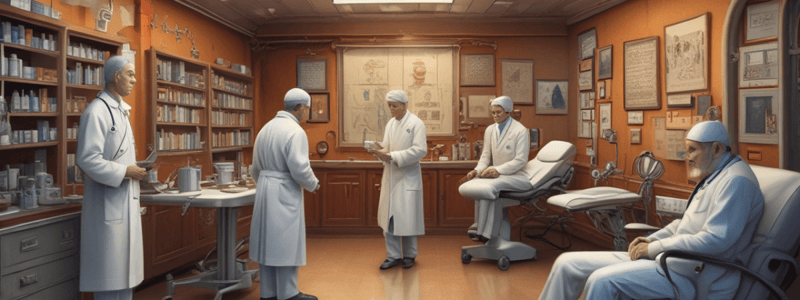Podcast
Questions and Answers
What is one of the essential elements of a patient's medical history?
What is one of the essential elements of a patient's medical history?
- Plan of care
- Medical terminology
- Vital signs (correct)
- Lab test results
What is the primary purpose of recording vital signs?
What is the primary purpose of recording vital signs?
- To identify patients at risk
- To diagnose medical conditions
- To monitor patient health and detect changes (correct)
- To educate patients on medical terminology
Where would a medical professional typically record patient data or lab test results?
Where would a medical professional typically record patient data or lab test results?
- Patient's medical history
- Medical terminology manual
- Patient's chart or electronic file (correct)
- Vital signs chart
What is an important aspect of carrying out a plan of care or orders?
What is an important aspect of carrying out a plan of care or orders?
Why is it important for medical professionals to use correct medical terminology?
Why is it important for medical professionals to use correct medical terminology?
What is a key aspect of identifying a patient's medical history?
What is a key aspect of identifying a patient's medical history?
What is a crucial step in recording and reporting vital signs?
What is a crucial step in recording and reporting vital signs?
When interpreting readings on various metering devices, what is essential?
When interpreting readings on various metering devices, what is essential?
What is a critical aspect of recording and filing patient data or lab test results?
What is a critical aspect of recording and filing patient data or lab test results?
When answering inquiries concerning patients, what is crucial?
When answering inquiries concerning patients, what is crucial?
What is the main purpose of identifying common elements of a patient's medical history?
What is the main purpose of identifying common elements of a patient's medical history?
Which of the following is a critical step in recording and reporting vital signs?
Which of the following is a critical step in recording and reporting vital signs?
What is the primary purpose of carrying out a plan of care or orders?
What is the primary purpose of carrying out a plan of care or orders?
Why is it important to use correct chart forms when recording patient data?
Why is it important to use correct chart forms when recording patient data?
What is the purpose of recording and filing patient data or lab test results?
What is the purpose of recording and filing patient data or lab test results?
Flashcards are hidden until you start studying
Study Notes
Medical History
- A patient's medical history includes common elements that provide important information for healthcare professionals to make informed decisions.
Recording Vital Signs
- Vital signs include temperature, pulse, respiration rate, blood pressure, and oxygen saturation, which must be recorded accurately and reported effectively.
Interpreting Meter Readings
- Healthcare professionals must be able to interpret readings on various metering devices, such as blood glucose meters, pulse oximeters, and blood pressure monitors.
Patient Responses
- Patients may respond in different ways during testing or treatment, and healthcare professionals must be able to identify and record these responses accurately.
Recording Patient Data
- Patient data, including lab test results, must be recorded manually and electronically with accuracy and attention to detail.
- Electronic records should be up-to-date and accurate to ensure continuity of care.
Communication
- Healthcare professionals must be able to answer inquiries from medical staff using correct medical terminology to ensure effective communication.
Plan of Care
- A plan of care outlines the patient's treatment goals and objectives, which healthcare professionals must carry out and update as necessary.
Charting Techniques
- Effective charting techniques are essential to ensure accurate and concise recording of patient information.
- This includes using correct chart forms and maintaining up-to-date records.
Chart Forms
- Healthcare professionals must identify and use the correct chart forms for different types of patient data, including medical history, vital signs, and test results.
Medical History
- A patient's medical history includes common elements that provide important information for healthcare professionals to make informed decisions.
Recording Vital Signs
- Vital signs include temperature, pulse, respiration rate, blood pressure, and oxygen saturation, which must be recorded accurately and reported effectively.
Interpreting Meter Readings
- Healthcare professionals must be able to interpret readings on various metering devices, such as blood glucose meters, pulse oximeters, and blood pressure monitors.
Patient Responses
- Patients may respond in different ways during testing or treatment, and healthcare professionals must be able to identify and record these responses accurately.
Recording Patient Data
- Patient data, including lab test results, must be recorded manually and electronically with accuracy and attention to detail.
- Electronic records should be up-to-date and accurate to ensure continuity of care.
Communication
- Healthcare professionals must be able to answer inquiries from medical staff using correct medical terminology to ensure effective communication.
Plan of Care
- A plan of care outlines the patient's treatment goals and objectives, which healthcare professionals must carry out and update as necessary.
Charting Techniques
- Effective charting techniques are essential to ensure accurate and concise recording of patient information.
- This includes using correct chart forms and maintaining up-to-date records.
Chart Forms
- Healthcare professionals must identify and use the correct chart forms for different types of patient data, including medical history, vital signs, and test results.
Medical History
- A patient's medical history includes common elements that provide important information for healthcare professionals to make informed decisions.
Recording Vital Signs
- Vital signs include temperature, pulse, respiration rate, blood pressure, and oxygen saturation, which must be recorded accurately and reported effectively.
Interpreting Meter Readings
- Healthcare professionals must be able to interpret readings on various metering devices, such as blood glucose meters, pulse oximeters, and blood pressure monitors.
Patient Responses
- Patients may respond in different ways during testing or treatment, and healthcare professionals must be able to identify and record these responses accurately.
Recording Patient Data
- Patient data, including lab test results, must be recorded manually and electronically with accuracy and attention to detail.
- Electronic records should be up-to-date and accurate to ensure continuity of care.
Communication
- Healthcare professionals must be able to answer inquiries from medical staff using correct medical terminology to ensure effective communication.
Plan of Care
- A plan of care outlines the patient's treatment goals and objectives, which healthcare professionals must carry out and update as necessary.
Charting Techniques
- Effective charting techniques are essential to ensure accurate and concise recording of patient information.
- This includes using correct chart forms and maintaining up-to-date records.
Chart Forms
- Healthcare professionals must identify and use the correct chart forms for different types of patient data, including medical history, vital signs, and test results.
Studying That Suits You
Use AI to generate personalized quizzes and flashcards to suit your learning preferences.




